Content
Beetroot Mulatka is one of the most popular table varieties. It has long become attractive to gardeners due to its taste, useful properties, and yield. For the successful cultivation of a root crop, it is necessary to follow the rules of agricultural technology, taking into account the characteristics of the variety.
Origin story
Table beet (Beta vulgaris L.ssp.vulgaris var. Conditiva Alef.) The mulatto was obtained in the eighties of the last century by the Soviet breeder Sergei Vasilyevich Maksimov. Work on improving the variety continued until 2001 at the Poisk agrofirm. Two years later, it was included in the register of breeding achievements of the Russian Federation and recommended for cultivation in most regions of the country, from Volgo-Vyatka to the Far East. Very quickly, mulatto beets became widespread, they began to cultivate them in the CIS countries, the European Union, and the United States.
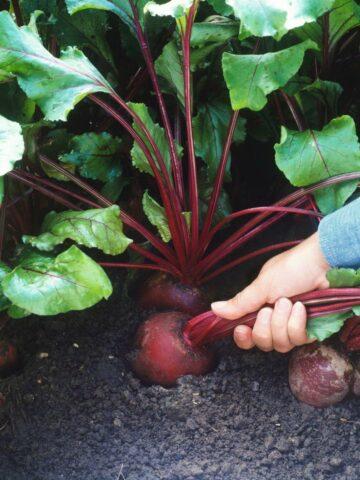
The popularity of the Mulatka variety is explained by the high quality of root crops and excellent transportability.
Description of beet variety Mulatka
In the stage of technical ripeness, beetroot Mulatka has rounded roots with smooth skin. Sometimes their heads can acquire a cork structure. The pulp is maroon, without cylindrical rings. The average weight of a vegetable is 200-400 g. The axial root is small, purple in color. Oval light green foliage of beet Mulatto forms an erect rosette up to 40 cm high. The petioles on the back are crimson. The edges of the leaf plates are wavy, the surface is slightly bubbly.
The taste qualities of the Mulatka variety are excellent. In the pulp of a vegetable, the sugar content is 14.5%, dry matter - up to 19.8%.
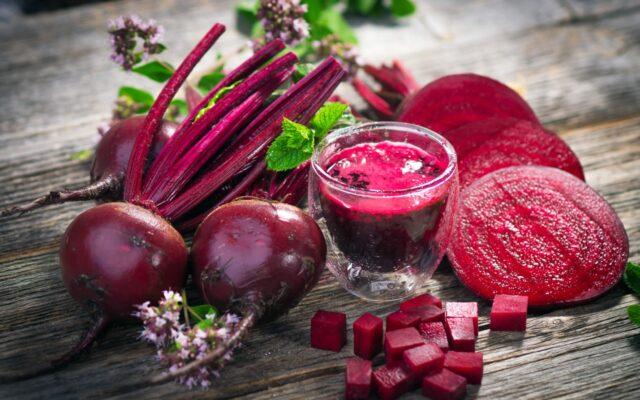
Beet roots have a high content of proteins, carbohydrates, vitamins, microelements
Characteristics of beet mulatto
The variety belongs to the canteen, it can be used in cooking, for harvesting and winter storage.
The period from the appearance of the first shoots to harvest is 130 days. The yield of mulatto beet depends on climatic conditions and soil composition. When grown on farms of the Central Black Earth Region, it is 250-400 c / ha, in the Moscow region - 200-300 c / ha. The yield of marketable products is high, up to 98%.
Frost resistance of mulatto beets is average, its seedlings easily tolerate recurrent frosts, and ripe root crops are resistant to a sharp drop in temperature.
Advantages and disadvantages
It is not difficult to grow mulatto beets, it does not require special care, it gives stable high yields.
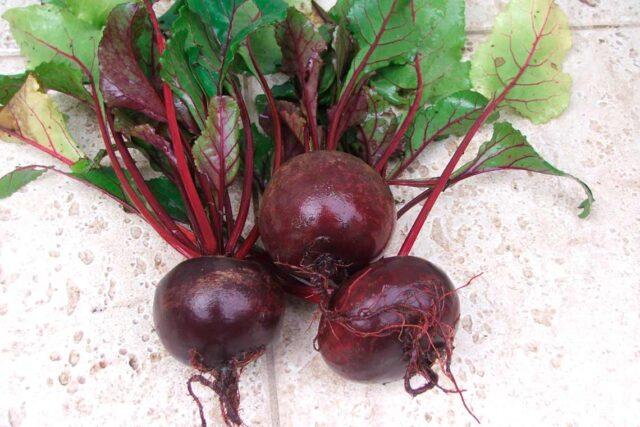
In the process of storage, root crops do not wither, retaining their presentation and useful properties until spring
Among the advantages of the Mulatka variety:
- great taste;
- attractive appearance;
- lack of white rings in the root crop;
- preservation of the bright color of beet pulp after heat treatment;
- long shelf life;
- high transportability;
- resistance to color.
Disadvantages:
- the need for good lighting;
- average resistance to pests and diseases.
Planting beet mulatto
To get an earlier crop of root crops, the seedling method is used, but most often the beets are sown directly in open ground.Loamy or sandy loam soil is suitable for cultivation. If its acidity is high, wood ash or dolomite flour (600 g per 1 m2).
Seedling method of growing
The method allows not only to get root crops a month earlier than usual, but also to avoid thinning the seedlings. In addition, beetroot mulatto, obtained by seedlings, has a more stable immunity to disease and pests. They act according to the scheme:
- The containers are filled with a soil mixture of compost, humus, sand and sawdust mixed in a ratio of 1: 1: 0.5: 0.5.
- Beet seeds are spread on the surface of the soil with an interval of 2 cm.
- Sprinkle with a thin layer of soil mixture.
- Moisturize.
- Cover the top with a film, glass or a transparent lid and transfer to a warm place (+20 ⁰С).
- After the appearance of the first shoots, the shelter is removed, and the temperature is reduced to +14 ⁰С.
- Ten days before disembarkation, the seedlings are hardened, exposing them to the open air, first for one hour, and after a few days - for five or six.
- For a week, watering the beetroot Mulatto is reduced, and the day before planting, the soil is moistened with a solution of potassium chloride (2 g per 1 liter of water).

Growing seedlings in a snail saves space and soil
Landing in open ground
Ready seedlings are planted after the threat of recurrent frosts has passed. The soil should warm up to +10 ⁰С. For mulatto beets, choose a sunny place without shading. Humus or well-decomposed compost (3 kg per 1 m2) and 30-40 g of complex mineral fertilizer. They dig shovels to the depth of the bayonet and make ridges. The holes are located at a distance of 5 cm. Their depth and volume should correspond to the size of the root system together with the earthy clod. A gap of 25 cm is left between the rows.
They start planting beetroot in cloudy rainy weather or in the evening. A transshipment method is used to maximize the integrity of the root system. The wells are watered, after which the seedlings are transferred into them and covered with soil.
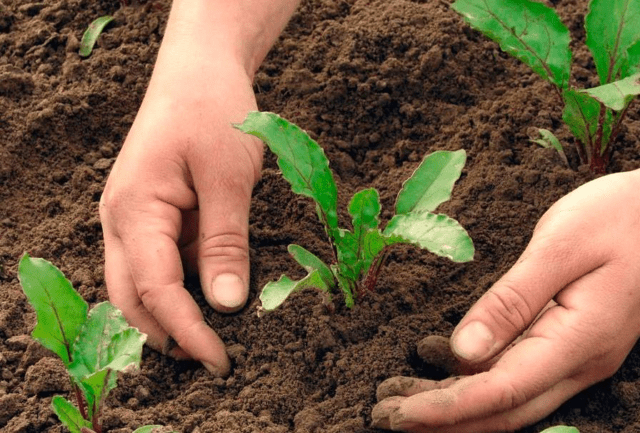
The root collar of the beet Mulatto should be located at the level of the soil surface
Seedlings are watered with a humate solution and covered with non-woven material for several days to protect fragile seedlings from direct sunlight.
You can also plant mulatto beets in open ground with seeds (dry or germinated). Untreated planting material (brown or beige) is first placed in a saline solution and after a few hours those seeds that have settled to the bottom are selected. After rinsing under running water, place them for 12 hours in a weak solution of potassium permanganate for disinfection, and then - for two hours in a growth stimulator ("Epin", "Zircon"). The seeds are placed in a warm place for a day, where they swell and peck. Then they act according to the scheme:
- On the prepared ridges, grooves are made with a depth of 2 cm.
- Water them.
- Seeds are spread at intervals of 2-8 cm.
- Fall asleep with a thin layer of soil.
- Water gently so as not to wash out the soil.
Beet Care Mulatto
The main agrotechnical measures when caring for mulatto beets are timely watering, weeding, loosening row spacings, and top dressing. You should focus on weather conditions, condition and appearance of plants.
Watering, weeding, loosening
Despite the fact that mulatto beets easily tolerate temporary drought, moistening should be carried out regularly, as the topsoil dries out. At first, the seedlings are watered every other day, later - twice a week. Irrigation is usually combined with the subsequent removal of weeds, loosening, mulching.
To increase the sugar content of root crops, watering is stopped 2-3 weeks before harvesting.
Top dressing
The use of mineral fertilizers can lead to cracking of root crops and the formation of voids in them. For feeding mulatto beets, organic matter should be used - a solution of mullein infusion (1: 8) or bird droppings (1:12). Consumption is 1.2 l per 1 m2 area. The solution is poured into the grooves prepared in advance, making them at a distance of 5 cm from the seedlings.
After the foliage closes, the plants are fed with wood ash (one glass per 1 m2) and watered abundantly.
Thinning
If not one plant has grown in the nest, but two or three, thinning is carried out, leaving the strongest. It is necessary to process thickened plantings of beets Mulatto if in the phase of 4-5 leaves the distance between seedlings is less than 5-6 cm.
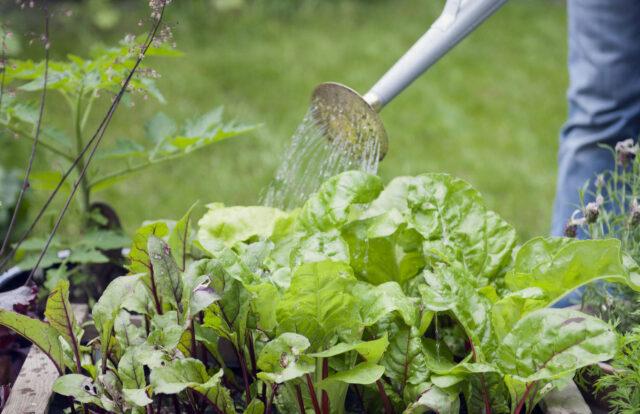
To increase the sugar content of root crops, beets are watered twice a season with a solution of sodium chloride (2 tablespoons per bucket of water)
Possible diseases and pests
In case of violation of agricultural technology and in difficult weather conditions, mulatto beets can be exposed to diseases and attack by pests. Timely response helps to deal with them and save the harvest.
Fomoz
Fungal disease affects foliage. Pale yellow or brown concentric rings with black dots appear on it. Later, their core rots and dries up. When the first signs of phomosis are found on mulatto beets, root feeding is carried out with brown, and the foliage is sprayed with a solution of boric acid.

The development of fomoz is provoked by prolonged rains, fogs, high humidity of the air and soil.
Peronosporosis
The defeat of downy mildew or peronosporosis looks like a purple-gray bloom on the back of the leaves. Later, their edges curl, and the leaf plate itself fades and dries up. Sick beetroots Mulatto lose keeping quality, rot.
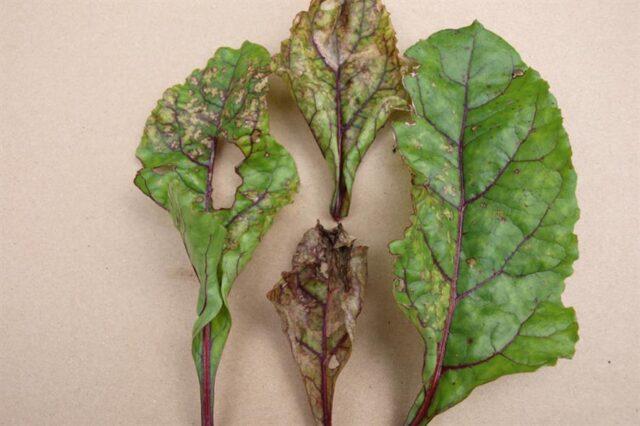
As a prophylaxis for peronosporosis, plants are sprayed with fungicides during the formation of root crops
Root or black leg
An infectious disease is dangerous for young seedlings of mulatto beet. When a rootworm is damaged, the stem turns black, becomes thin, the plant dies. Most often, the root grower develops on heavy soil with a lack of oxygen in the soil and its high acidity.
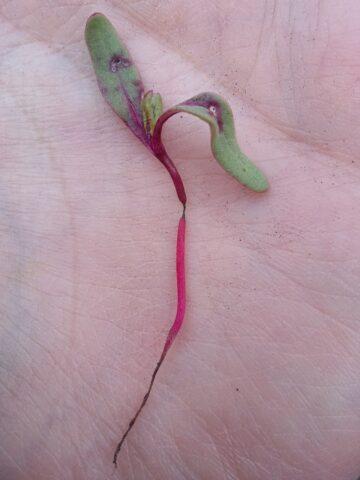
In order to prevent blackleg in the fall, liming of the soil and treatment with borax solution are carried out
Of the insects, the greatest danger to mulatto beets is aphids, scale insects, beet flies, scoops, fleas. To combat the first pest, spraying with onion peel infusion is used. You can get rid of beet flies, scoops, fleas and scale insects using insecticides (Iskra Bio) or biological products (Gomelin, Bitoxibacillin).
Conclusion
Beet Mulatka is unpretentious, grows well on any soil, except for acidic and waterlogged. With minimal maintenance, the variety gives a guaranteed yield of root crops with excellent taste, so gardeners have been choosing it for many years.
Reviews of gardeners about beets Mulatka








